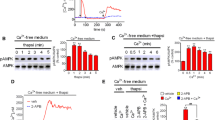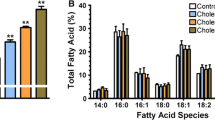Abstract
Many membrane-bound neurotransmitter receptors are known to be internalized by exposure to agonist. This agonist-induced receptor internalization is considered to play important roles in receptor-mediated signaling. Here we investigated the internalization of GAR-3, a Caenorhabditis elegans muscarinic acetylcholine receptor, using cultured mammalian cells. When Chinese hamster ovary cells stably expressing GAR-3 were treated with carbachol, GAR-3 was internalized in a dose- and time-dependent manner. Approximately 60% of the cell surface receptor was internalized by exposure to 1 mM carbachol for 1 h. Carbachol-induced GAR-3 internalization was suppressed by treatment with hypertonic sucrose, which blocks the formation of clathrin-coated pits. Overexpression of a dominant-negative dynamin mutant (DynK44A), but not of a dominant-negative β-arrestin mutant (Arr319–418), substantially inhibited carbachol-induced internalization of GAR-3. Thus, these data suggest that GAR-3 undergoes agonist-induced internalization via a clathrin- and dynamin-dependent but β-arrestin-independent pathway. Depletion of Ca2+ by simultaneous treatment of the cells with BAPTA/AM (Ca2+ mobilization blocker) and EGTA (Ca2+ influx blocker) almost completely blocked agonist-induced GAR-3 internalization. Moreover, treatment of the cells with the Ca2+ ionophore A23187 led to GAR-3 internalization in the absence of agonist. These results indicate that Ca2+ plays a critical role in GAR-3 internalization. We tested whether the third intracellular (i3) loop of GAR-3 is involved in agonist-stimulated receptor internalization. A GAR-3 deletion mutant lacking a large central portion of the i3 loop exhibited an internalization pattern comparable to that of the wild type, suggesting that the central i3 loop is not required for the internalization of GAR-3.




Similar content being viewed by others
Abbreviations
- C. elegans :
-
Caenorhabditis elegans
- CaMKII:
-
Ca2+/calmodulin-depedndent protein kinase II
- CHO:
-
Chinese hamster ovary
- GPCR:
-
G-protein-coupled receptor
- i3 loop:
-
third intracellular loop
- mAChR:
-
muscarinic acetylcholine receptor
- [3H]NMS:
-
[3H]N-methylscopolamine
- PKC:
-
protein kinase C
References
Claing A, Laporte SA, Caron MG, Lefkowitz RJ (2002) Endocytosis of G protein-coupled receptors: roles of G protein-coupled receptor kinases and β-arrestin proteins. Prog Neurobiol 66:61–79
Bunemann M, Lee KB, Pals-Rylaarsdam R, Roseberry AG, Hosey MM (1999) Desensitization of G-protein-coupled receptors in the cardiovascular system. Annu Rev Physiol 61:169–192
van Koppen CJ, Kaiser B (2003) Regulation of muscarinic acetylcholine receptor signaling. Pharmacol Ther 98:197–220
Ferguson SSG (2001) Evolving concepts in G protein-coupled receptor endocytosis: the role in receptor desensitization and signaling. Pharmacol Rev 53:1–24
von Zastrow M (2003) Mechanisms regulating membrane trafficking of G protein-coupled receptors in the endocytic pathway. Life Sci 74:217–224
Yu SS, Lefkowitz RJ, Hausdorff WP (1993) β-adrenergic receptor sequestration. J Biol Chem 268:337–341
Barak LS, Tiberi M, Freedman NJ, Kwatra MM, Lefkowitz RJ, Caron MG (1994) A highly conserved tyrosine residue in G protein-coupled receptors is required for agonist-mediated β2-adrenergic receptor sequestration. J Biol Chem 269:2790–2795
Szekeres PG, Koenig JA, Edwardson JM (1998) Involvement of receptor cycling and receptor reserve in resensitization of muscarinic responses in SH-SY5Y human neuroblastoma cells. J Neurochem 70:1694–1703
Ishii I, Saito E, Izumi T, Ui M, Shimizu T (1998) Agonist-induced sequestration, recycling, and resensitization of platelet-activating factor receptor. J Biol Chem 273:9878–9885
Hasbi A, Allouche S, Sichel F, Stanasila L, Massotte D, Landemore G, Polastron J, Jauzac P (2000) Internalization and recycling of δ-opioid receptor are dependent on a phospharylation-dephosphorylation mechanism. J Pharmacol Exp Ther 293:237–247
Daaka Y, Luttrell LM, Ahn S, Della Rocca GJ, Ferguson SSG, Caron MG, Lefkowitz RJ (1998) Essential role for G-protein-coupled receptor endocytosis in the activation of mitogen-activated protein kinase. J Biol Chem 273:685–688
Vogler O, Nolte B, Voss M, Schmidt M, Jakobs KH, van Koppen CJ (1999) Regulation of muscarinic acetylcholine receptor sequestration and function by β-arrestin. J Biol Chem 274:12333–12338
Ignatova EG, Belcheva MM, Bohn LM, Neuman MC, Coscia CJ (1999) Requirement of receptor internalization for opioid stimulation of mitogen-activated protein kinase: biochemical and immunofluorescence confocal microscopic evidence. J Neurosci 19:56–63
DeFea KA, Zalevsky J, Thoma MS, Dery O, Mullins RD, Bunnett NW (2000) β-arrestin-dependent endocytosis of proteinase-activated receptor 2 is required for intracellular targeting of activated ERK1/2. J Cell Biol 148:1267–1281
Bunemann M, Hosey MM (1999) G-protein coupled receptor kinases as modulators of G-protein signaling. J Physiol 517:5–23
Prossnitz ER (2004) Novel roles for arrestins in the post-endocytic trafficking of G protein-coupled receptors. Life Sci 75:893–899
Lee Y-S, Park Y-S, Chang D-J, Hwang JM, Min CK, Kaang B-K, Cho NJ (1999) Cloning and expression of a G protein-linked acetylcholine receptor from Caenorhabditis elegans. J Neurochem 72:58–65
Lee Y-S, Park Y-S, Nam S, Suh SJ, Lee J, Kaang B-K, Cho NJ (2000) Characterization of GAR-2, a novel G protein-linked acetylcholine receptor from Caenorhabditis elegans. J Neurochem 75:1800–1809
Hwang JM, Chang D-J, Kim US, Lee Y-S, Park Y-S, Kaang B-K, Cho NJ (1999) Cloning and functional characterization of a Caenorhabditis elegans muscarinic acetylcholine receptor. Receptor Channel 6: 415–424
Park Y-S, Kim S, Shin Y, Choi B, Cho NJ (2003) Alternative splicing of the muscarinic acetylcholine receptor GAR-3 in Caenorhabditis elegans. Biochem. Biophys Res Commun 308:961–965
Harden TK, Petch LA, Traynelis SF, Waldo GL (1985) Agonist-induced alteration in the membrane form of muscarinic cholinergic receptors. J Biol Chem 260:13060–13066
Goldman PS, Nathanson NM (1994) Differential role of the carboxyl-terminal tyrosine in down-regulation and sequestration of the m2 muscarinic acetylcholine receptor. J Biol Chem 269:15640–15645
Heuser JE, Anderson RGW (1989) Hypertonic media inhibit receptor-mediated endocytosis by blocking clathrin-coated pit formation. J Cell Biol 108:389–400
Slowiejko DM, McEwen EL, Ernst SA, Fisher SK (1996) Muscarinic receptor sequestration in SH-SY5Y neuroblastoma cells is inhibited when clathrin distribution is perturbed. J Neurochem 66:186–196
Damke H, Baba T, Warnock DE, Schmid SL (1994) Induction of mutant dynamin specifically blocks endocytic coated vesicle formation. J Cell Biol 127:915–934
Krupnick JG, Santini F, Gagnon AW, Keen JH, Benovic JL (1997) Modulation of the arrestin-clathrin interaction in cells. J Biol Chem 272:32507–32512
Min DS, Cho NJ, Yoon SH, Lee YH, Hahn SJ, Lee KH, Kim MS, Jo YH (2000) Phospholipase C, protein kinase C, Ca2+/calmodulin-dependent protein kinase II, and tyrosine phosphorylation are involved in carbachol-induced phospholipase D activation in Chinese hamster ovary cells expressing muscarinic acetylcholine receptor of Caenorhabditis elegans. J Neurochem 75:274–281
Maeda S, Lameh J, Mallet WG, Philip M, Ramachandran J, Sadee W (1990) Internalization of the Hm1 muscarinic cholinergic receptor involves the third cytoplasmic loop. FEBS Lett 269:386–388
Lameh J, Philip M, Sharma YK, Moro O, Ramachandran J, Sadee W (1992) Hm1 muscarinic cholinergic receptor internalization requires a domain in the third cytoplasmic loop. J Biol Chem 267:13406–13412
Moro O, Lameh J, Sadee W (1993) Serine- and threonine-rich domain regulates internalization of muscarinic cholinergic receptors. J Biol Chem 268:6862–6865
Tsuga H, Kameyama K, Haga T, Honma T, Lameh J, Sadee W (1998) Internalization and down-regulation of human muscarinic acetylcholine receptor m2 subtypes. J Biol Chem 273:5323–5330
Wu G, Bogatkevich GS, Mukhin YV, Benovic JL, Hildebrandt JD, Lanier SM (2000) Identification of Gβγ binding sites in the third intracellular loop of the M3-muscarinic receptor and their role in receptor regulation. J Biol Chem 275: 9026–9034
Putney JW (2001) Channelling calcium. Nature 410:648–649
Ferrari SL, Behar V, Chorev M, Rosenblatt M, Bisello A (1999) Endocytosis of ligand-human parathyroid hormone receptor 1 complexes is protein kinase C-dependent and involves β-arrestin2. J Biol Chem 274:29968–29975
Mundell SJ, Matharu A-L, Pula G, Holman D, Roberts J, Kelly E (2002) Metabotropic glutamate receptor 1 internalization induced by muscarinic acetylcholine receptor activation: differential dependency of internalization of splice variants on nonvisual arrestins. Mol Pharmacol 61:1114–1123
Vogler O, Bogatkewitsch GS, Wriske C, Krummenerl P, Jakobs KH, van Koppen CJ (1998) Receptor subtype-specific regulation of muscarinic acetylcholine receptor sequestration by dynamin. J Biol Chem 273:12155–12160
Lee KB, Pals-Rylaarsdam R, Benovic JL, Hosey MM (1998) Arrestin-independent internalization of the m1, m3, and m4 subtypes of muscarinic cholinergic receptors. J Biol Chem 273:12967–12972
Acknowledgements
We thank Dr. Ja-Hyun Baik (Korea University, Korea) for her valuable suggestions. We also thank Dr. Eamonn Kelly (University of Bristol, UK) for providing the DynK44A and Arr319–418 plasmids. This work was supported by Korea Research Foundation Grant (KRF-2003-015-C00578).
Author information
Authors and Affiliations
Corresponding author
Rights and permissions
About this article
Cite this article
Choi, B., Park, YS. & Cho, N.J. Agonist-induced Internalization of the Caenorhabditis elegans Muscarinic Acetylcholine Receptor GAR-3 in Chinese Hamster Ovary Cells. Neurochem Res 31, 719–725 (2006). https://doi.org/10.1007/s11064-006-9072-4
Accepted:
Published:
Issue Date:
DOI: https://doi.org/10.1007/s11064-006-9072-4




